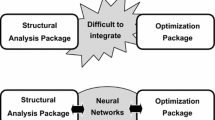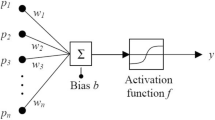Abstract
An efficient multi-objective optimization method is presented making use of neural network and a systematic satisficing trade-off method (STOM), in order to simultaneously improve both maneuverability and durability of tire. Objective functions are defined as follows: the sidewall-carcass tension distribution for the former performance while the belt-edge strain energy density for the latter. A back-propagation neural network model approximates the objective functions to reduce the total CPU time required for the sensitivity analysis using finite difference scheme. The satisficing trade-off process between the objective functions showing the remarkably conflicting trends each other is systematically carried out according to our aspiration-level adjustment procedure. The optimization procedure presented is illustrated through the optimum design simulation of a representative automobile tire. The assessment of its numerical merit as well as the optimization results is also presented.
Similar content being viewed by others
References
ABAQUS Standard User’s Manual, Version 5. 8. Hibbitt, Karlsson & Sorensen, Inc.: Pawtucket, 1998.
Chang, J. P., Satyamurthy, K. and Tseng, N. T., 1988, “An efficient approach for three dimensional finite element analysis of tires,”Tire Science and Technology TSTCA, Vol. 16, p. 249–273.
Cho, J. R., Jeong, H. S., Kim, N. J. and Kim, K. W., 2002, “Application of STOM to the optimal tire contour Design by Introducing the Aspiration-Level Indicator,”Tire Science and Technology TSTCA, Vol. 30, No. 4, p. 265–288.
Clark, S. K., 1982,Mechanics of Pneumatic Tires, Government Printing Office, Washington DC.
Fausett, L., 1994,Fundamentals of Neural Networks, Prentice-Hall, New Jersey.
I-DEAS Master Series, Release 9, Structural Dynamics Research Corporation: Ohio, 2002.
Nakayama, H. and Furukawa, K., 1985, “Satisficing trade-off method with an application to multiobjective structural design,”Large Scale Systems, Vol. 8, p. 47–57.
Purdy, J. F., 1963,Mathematics Underlying Design of Pneumatic Tires, Edwards Brothers, Michigan.
Ross, P. J., 1988,Taguchi Techniques for Quality Engineering, McGraw-Hill, New York.
Sawaragi, Y., Nakayama, H. and Tanino, T., 1985,Theory of Multiobjective Optimization, Academic Press, New York.
Vanderplaats, G. N., 1984,Numerical Optimization Techniques for Engineering Design with Applications, McGraw-Hill, Singapore.
Yamagishi, K., Togashi, M., Furuya, S., Tsukahara, K. and Yoshimura, N., 1987, “A Study on the Contour of the Radial Tire: rolling optimization theory (RCOT),”Tire Science and Technology TSTCA, Vol. 15, No. 1, p. 3–29.
Author information
Authors and Affiliations
Corresponding author
Rights and permissions
About this article
Cite this article
Cho, JR., Jeong, HS., Yoo, WS. et al. Optimum tire contour design using systematic stom and neural network. KSME International Journal 18, 1327–1337 (2004). https://doi.org/10.1007/BF02984247
Received:
Revised:
Published:
Issue Date:
DOI: https://doi.org/10.1007/BF02984247




